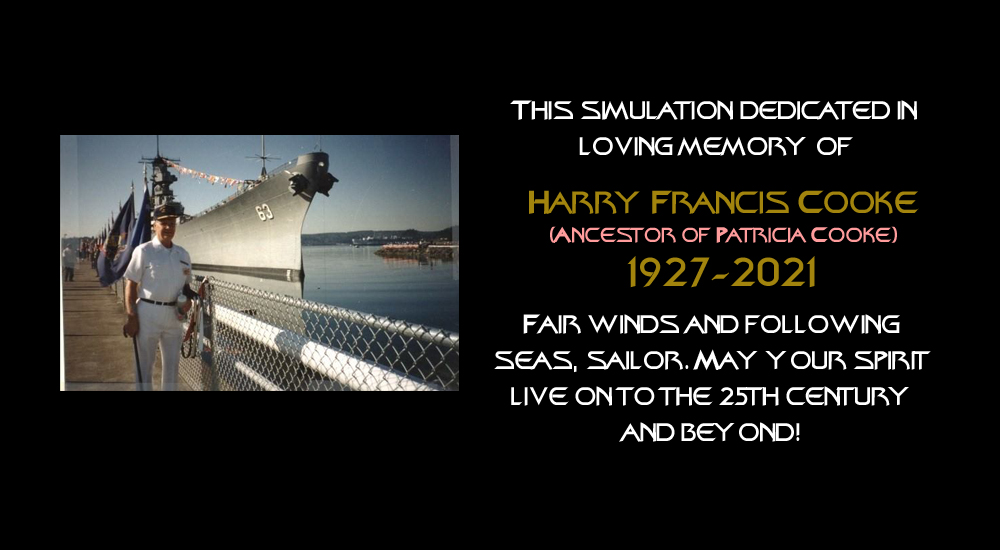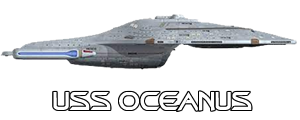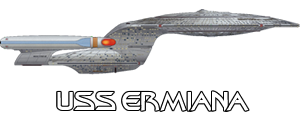The Sim

The USS Missouri is a Bellerophon Class starship currently serving in Theta Fleet's Area 51.
Unofficially nicknamed the "Show Me State," the state of Missouri in the Midwestern United States is named for the Missouri River, which in and of itself is named after the indigenous Missouria tribe. (Spelled Niutachi in their own language) French colonists adapted a form of the Illinois language name of the tribe: Wimihsoorita. Their name means "one who has dugout canoes."
History of the Missouri (1841-2400)
Named after the US State of Missouri, the 24th state admitted to the union, the USS Missouri has a long history of many different ships dating back to the 1840s and has had a huge impact on the naval capacity of both the United States of America and the United Federation of Planets.
%20USS%20Missouri%201841.jpg)
On August 6, 1843, the Missouri embarked Caleb Cushing, the US Minister to China, bound for Alexandria, Egypt on the first leg of Cushing’s journey to negotiate the first commercial treaty with China. The ship arrived in Gibraltar on August 25, 1843, and anchored in the Gibraltar harbor. On the night of August 26, the engineer’s yeoman accidentally broke and ignited a demijohn of turpentine in the ship’s storeroom. The flames spread so quickly that the crew was forced to abandon ship. Fortunately, Minister Cushing was able to save his letter to the Daoguang Emperor of China, saving his mission as a result. In the span of four hours, the steam frigate was reduced to a blackened and sinking hulk before finally, at 3:20 AM on the morning of the 27th, the forward powder magazine exploded, finishing off what remained of the still-burning ship.
HMS Malabar assisted the Missouri in fighting the fire and took aboard some 200 survivors. Sir Robert Wilson, the governor of Gibraltar at the time, opened the gates of Gibraltar to the Missouri survivors in an act of courtesy which was recognized by a resolution of appreciation from Congress. What remained of the Missouri was a hazard to navigation, and the wreck was later removed by divers from the harbor’s shallow waters. Ultimately, Captain Newton was court martialed for negligence in regards to the loss of the ship, and was found guilty, being sentenced to suspension from service until March 3, 1845, when US President John Tyler remitted the rest of Newton’s sentence.
%20USS%20Missouri%20(BB-11).jpg)
The Missouri was decommissioned in 1910, though she was periodically reactivated for summer training cruises over the next six years. After the United States entered Earth’s First World War in 1917, the Missouri was brought back into permanent service to train personnel for the expanding wartime navy. She served briefly as a troopship in 1919, ferrying American soldiers back from France, before she was decommissioned for good in September of 1919. Ultimately the Missouri was sold for scrap in 1922, and met her demise at the cutter’s torch.
%20USS%20Missouri%20(BB-63).jpg)
After her commissioning, the Missouri was assigned to the Pacific Theater of Earth’s Second World War, where she participated in the battles of Iwo Jima and Okinawa and had a part in the shelling of the Japanese home islands. Her quarterdeck was the site of the surrender of the Empire of Japan on September 2nd, 1945, ending World War II. A notable crewmember who served aboard the Missouri during this era was Seaman 1st Class Harry Francis Cooke, a plank owner of the vessel from Des Plaines, Illinois who served aboard from June 10, 1944 until March 24, 1947, the day before his 20th birthday.
After World War II, the Missouri served in various diplomatic, show of force, and training missions. On January 17, 1950, the ship ran aground during high tide in Chesapeake Bay, and after great effort, was refloated a few weeks later. The Missouri later fought in the Korean War during two tours between 1950 and 1953. The Missouri was the first American battleship on scene and served as the flagship of several Admirals. The ship took part in numerous shore bombardment operations and served in a screening role for American aircraft carriers. After eleven continuous years of service, the Missouri was decommissioned on February 26, 1955 and placed in a reserve fleet.
However, in 1984, the Missouri was reactivated and modernized as part of the 600 ship navy plan under US President Ronald Reagan. Cruise and anti-ship missile launchers were added along with updated electronics. The Missouri’s original aircraft catapults were removed and replaced with a helicopter pad. The ship served in the Persian Gulf escorting oil tankers amidst threats from Iran, often while keeping her fire control systems trained on land-based Iranian missile launchers. In 1991, the Missouri served in Operation Desert Storm and provided fire support to coalition forces.
In 1992, the Missouri was decommissioned for the last time, though she remained on the naval vessel register until she was struck in 1995. In 1998, she was donated to the USS Missouri Memorial Association and became a museum ship at Pearl Harbor, Hawaii. She was strategically placed so that her bow faced the USS Arizona Memorial above the wreck of the USS Arizona to convey that the Missouri watches over the remains of the Arizona so that the crewmembers interred within Arizona’s hull may rest in peace.
%20USS%20Missouri%20(SSN-780).jpg)
The Missouri completed her first 6 month deployment to the United States 6th Fleet on December 20, 2013. Three months later, in March of 2014, the Missouri made an 11 week long surge deployment in the North Atlantic. While unconfirmed, the Missouri’s deployment was likely linked to the annexation of Crimea by the Russian Federation, which occurred that exact same month. The Missouri served with the 6th fleet through 2015.
On January 26, 2018, the Missouri sailed into her new homeport of Pearl Harbor, Hawaii from Groton, Connecticut. On March 31, 2022, the Missouri returned to Pearl Harbor following a deployment to the 7th fleet. The Missouri remained in active service with the US Pacific Fleet as of 2022.
%20USS%20Missouri%20(NCC-1526).jpg)
Rumors of her reactivation persisted until 2344, when Starfleet announced that the Missouri would be added to the Fleet Museum. Restored to the condition she was in when her last crew disembarked and put on display in 2345, the Missouri would serve as the Museum's example of the Miranda class' late 23rd century configuration: A contrast to a later addition to the Museum's collection: The Missouri's contemporary, the USS Saratoga, which was controversially updated to a 2360s configuration to pay tribute to the Saratoga which was lost at Wolf 359, on which Benjamin Sisko had served as First Officer.
%20USS%20Missouri%20(NCC-1810).png)
Three years later in 2373, the Missouri was pulled out of Mothballs to bolster Starfleet’s numbers following the outbreak of the Dominion War. When she was reactivated, some of her less essential facilities were ripped out so accommodations could be made to station a marine garrison on the vessel. This is how Starfleet marine Francine Cooke, who made the rank of Major before she resigned her commission in 2376, came to be assigned to the Missouri. She was present at major engagements such as Operation Return, the first battle of Chin’toka, and the Battle of Cardassia. The Missouri racked up an impressive kill streak over the course of the war, destroying the most Jem’Hadar cruisers out of any surviving Excelsior class starship, earning herself the nickname “The Old Reliable.”
The Missouri was present at Deep Space 9 when the Treaty of Bajor was signed, formally ending the Dominion War. After which, the Missouri was transferred to the Third Fleet to bolster their numbers after the heavy losses they suffered during the war, and she was assigned peacekeeping duties in Cardassian space while the Cardassians rebuilt. She would remain in Cardassian space until 2378, when she received orders to return to Earth Spacedock, where she was to be decommissioned for the second and final time.
%20USS%20Missouri%20(NCC-76241).jpg)
However, in late 2392, Captain Izumi's husband was murdered, leaving her alone with her daughter who was only around six months old at the time. Therefore Captain Izumi stepped down from her Command Duties as the ship pulled in for a six week resupply and overhaul. Captain Aika Tenku, a recently promoted officer was then placed in command to take the Missouri to the far edge of Federation Space to begin what was known as the Heartfilia Project.
In 2394, The Missouri mysteriously vanished shortly after leaving Starbase 472 after a routine resupply. A two year search for the Missouri concluded in 2396 with the Missouri being declared lost with all hands. In the years following the Missouri’s disappearance and the cessation of the search, several conspiracy theories surfaced attempting to explain what might have possibly happened, ranging from Romulan sabotage to Borg assimilation.
%20alt%205.jpg)
Starfleet only partially confirmed suspicions when they indeed announced the discontinuation of the Intrepid II class shortly thereafter. All Intrepid II class starships currently in a state of near completion would be allowed to be completed as such. However, those ships that were less far along in the construction process would be reevaluated for conversion into one of three new Intrepid subclasses being rolled out: Cochrane, Discovery, and Bellerophon.
The incomplete Branson was determined to be best suited for conversion into a Bellerophon Class Starship; the Intrepid subclass which borrowed design elements from Starfleet’s newest class of starship; the Odyssey Class. As work on the Branson had barely gotten past the keel before the stop work order, there was very little that needed to be done in regards to the conversion, and work resumed on the Branson as 2397 began.
In 2398, then-Commodore Kagami Izumi visited Manhattan Fleet Yards to get an update on the progress of the Branson’s construction along with the construction of the other Bellerophon, Cochrane, and Discovery classes Manhattan was currently building. The dock staff working on the Branson told Commodore Izumi that the Branson was currently scheduled for completion by the end of 2399, and would be ready for her shakedown cruise by early 2400. After presenting the construction update to her superiors, Commodore Izumi put in a request to have the vessel’s name changed from Branson to Missouri. However, her request was only partially granted, as the Missouri would retain the Branson’s planned hull number.
Construction of the Branson, now renamed Missouri, was completed before Manhattan’s yard shutdown ahead of the holidays, and the Missouri’s shakedown cruise was scheduled to commence after the New Years’ celebrations in early January 2400. The officer selected to command this new Missouri was Commander Patricia Cooke; a young officer with strong lineage ties to the Missouri name, as her grandmother had served aboard the Excelsior Class Missouri during the Dominion War. Furthermore, her ancestor had been a plank owner of the Iowa Class Battleship from Earth’s Second World War. Selected to be Cooke’s Executive Officer was none other than now-Rear Admiral Kagami Izumi’s younger sister, Lieutenant Commander Tsukasa Izumi.
However, in the early hours of New Year's Day 2400, Camp Khitomer, where most of the Missouri's initially-assigned crew were located, was attacked by a mysterious AI known as I-400. In light of the attack, Commander Cooke convinced Admiral Izumi to take the Missouri out to track down and eliminate the I-400 threat. During the extensive search for I-400, Commander Izumi left the Missouri and was replaced by Commander Katrina Chance.
Following the final defeat of I-400, Starfleet's Corps of Engineers decided to halt production on the Discovery and Cochrane classes and cancel the upcoming Pathfinder and Trailblazer classes in favor of putting the Bellerophon class into full production.
USS Missouri Award Archive
USS Missouri Fleet Awards 2024
 Bronze Unit of Distinction, April 2024
Bronze Unit of Distinction, April 2024 Bronze Unit of Distinction, June 2024
Bronze Unit of Distinction, June 2024 Silver Unit of Distinction, August 2024
Silver Unit of Distinction, August 2024 Silver Unit of Distinction, September 2024
Silver Unit of Distinction, September 2024 Bronze Unit of Distinction, October 2024
Bronze Unit of Distinction, October 2024USS Missouri Fleet Awards 2023
 Bronze Unit of Distinction, February 2023
Bronze Unit of Distinction, February 2023 Bronze Unit of Distinction, March 2023
Bronze Unit of Distinction, March 2023 Silver Unit of Distinction, July 2023
Silver Unit of Distinction, July 2023 Bronze Unit of Distinction, November 2023
Bronze Unit of Distinction, November 2023 Player of the Month, awarded to Chris A.K.A. Drauc ie-Jia'anKahr, November 2023
Player of the Month, awarded to Chris A.K.A. Drauc ie-Jia'anKahr, November 2023 Bronze Unit of Distinction, December 2023
Bronze Unit of Distinction, December 2023 Writer of the Month, awarded to Drakomis A.K.A. Eradaar Ezazzan, December 2023
Writer of the Month, awarded to Drakomis A.K.A. Eradaar Ezazzan, December 2023Check out our Sister Sims!



